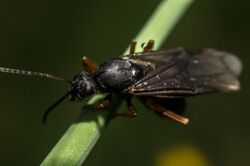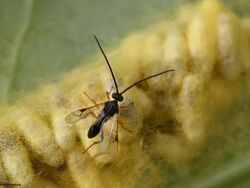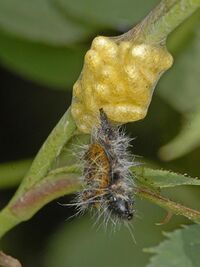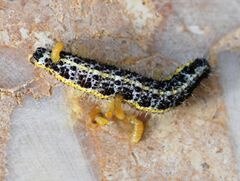Biology:Cotesia glomerata
| Cotesia glomerata | |
|---|---|

| |
| Cotesia glomerata | |

| |
| Cotesia glomerata on a pupal cocoon. | |
| Scientific classification | |
| Domain: | Eukaryota |
| Kingdom: | Animalia |
| Phylum: | Arthropoda |
| Class: | Insecta |
| Order: | Hymenoptera |
| Family: | Braconidae |
| Genus: | Cotesia |
| Species: | C. glomerata
|
| Binomial name | |
| Cotesia glomerata | |
| Synonyms | |
| |
Cotesia glomerata, the white butterfly parasite, is a small parasitoid wasp belonging to family Braconidae. It was described by Carl Linnaeus in his 1758 publication 10th edition of Systema Naturae.
Description


The adults of Cotesia glomerata can reach a length of 3–7 millimetres (0.12–0.28 in). This small braconid wasp is black, with two pairs of wings. It can parasitize a wide range of Pieris butterfly species as host, but the large white (Pieris brassicae) and small white (Pieris rapae) are the main hosts. The adults feed on nectar. [2]
Life cycle
After hatching from the pupae, females mate almost immediately and begin laying eggs.[3] The eggs are laid in the larvae of butterflies known as caterpillars, where the C. glomerata larvae develop; multiple eggs numbering between 16–52 are deposited in each caterpillar.[4] After 15 to 20 days the larvae emerge, usually killing the parasitised caterpillar. These newly emerged larvae spin cocoons in a cluster on or nearby the host caterpillar; after 7 to 10 days the imago adult wasps hatch from these cocoons. Males typically emerge before females and disperse from the area.[5] Overall, it takes between 22 and 30 days for an egg to develop to full adulthood. [3]
Cotesia glomerata is in turn parasitized by the hyperparasite wasps Lysibia nana and Gelis agilis.[6]
Distribution
This species is present in most of Europe, in the Afrotropical realm, the Australasian realm, the Nearctic realm, and the Neotropical realm.[7]
References
- ↑ " Cotesia glomerata (Linnaeus, 1758)". https://www.biolib.cz/en/taxon/id66437/.
- ↑ Laing, J.E.; Levin, D.B. (1982). "A review of the biology and a bibliography of Apanteles glomeratus (L.) (Hymenoptera: Braconidae)". Biocontrol News and Information 3 (1): 7–23. ISSN 0143-1404.
- ↑ 3.0 3.1 Cornell University College of Agricultural and Life Sciences Cotesia (=Apanteles) glomerata (Hymenoptera: Braconidae)
- ↑ Susan Mahr, University of Wisconsin Cotesia glomerata, Parasite of Imported Cabbageworm
- ↑ Gu, Hainan; Dorn, Silvia (August 2003). "Mating system and sex allocation in the gregarious parasitoid Cotesia glomerata". Animal Behaviour 66 (2): 259–264. doi:10.1006/anbe.2003.2185.
- ↑ Harvey, Jeffrey A. (2008-03-01). "Comparing and contrasting development and reproductive strategies in the pupal hyperparasitoids Lysibia nana and Gelis agilis (Hymenoptera: Ichneumonidae)" (in en). Evolutionary Ecology 22 (2): 153–166. doi:10.1007/s10682-007-9164-x. ISSN 0269-7653.
- ↑ "Cotesia glomerata (Linnaeus, 1758)". https://fauna-eu.org/cdm_dataportal/taxon/465a17b7-b0a8-4007-b2d3-1a60ac145130.
Further reading
- Karowe, D. N.; Schoonhoven, L. M. (1992). "Interactions among three trophic levels: The influence of host plant on performance of Pieris brassicae and its parasitoid, Cotesia glomerata". Entomologia Experimentalis et Applicata 62 (3): 241–51. doi:10.1111/j.1570-7458.1992.tb00664.x.
- Mattiacci, Letizia; Dicke, Marcel (1995). "Host-age discrimination during host location by Cotesia glomerata, a larval parasitoid of Pieris brassicae". Entomologia Experimentalis et Applicata 76: 37–48. doi:10.1111/j.1570-7458.1995.tb01944.x.
- Wäckers, F.L. (2001). "A comparison of nectar- and honeydew sugars with respect to their utilization by the hymenopteran parasitoid Cotesia glomerata". Journal of Insect Physiology 47 (9): 1077–1084. doi:10.1016/S0022-1910(01)00088-9. PMID 11472770.
- Coleman, R. A.; Barker, A. M.; Fenner, M. (1999). "Parasitism of the herbivore Pieris brassicae L. (Lep., Pieridae) by Cotesia glomerata L. (Hym., Braconidae) does not benefit the host plant by reduction of herbivory". Journal of Applied Entomology 123 (3): 171–7. doi:10.1046/j.1439-0418.1999.00334.x.
- Gu, Hainan; Wang, Qun; Dorn, Silvia (2003). "Superparasitism in Cotesia glomerata: Response of hosts and consequences for parasitoids". Ecological Entomology 28 (4): 422–31. doi:10.1046/j.1365-2311.2003.00535.x.
External links
- "Wasps Emerge From Caterpillar". Parasitic Wasps: Alien on Earth. In the Womb: Extreme Animals. National Geographic. May 16, 2009. https://www.youtube.com/watch?v=vMG-LWyNcAs.
- An 9 minute video of the wasps behaviour.
- Entomology
Wikidata ☰ Q474464 entry
 |

